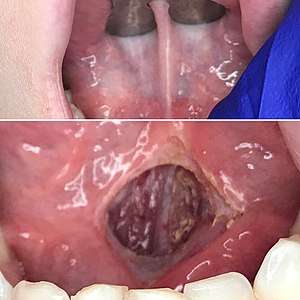Frenectomy

A frenectomy (also known as a frenulectomy or frenotomy) is the removal of a frenulum, a small fold of tissue that prevents an organ in the body from moving too far. It can refer to frenula in several places on the human body. It is related to frenuloplasty, a surgical alteration in a frenulum. Done mostly for orthodontic purposes, a frenectomy is either performed inside the middle of upper lip, which is called labial frenectomy, or under the tongue, called lingual frenectomy. Frenectomy is a very common dental procedure that is performed on infants, children, and adults. A similar procedure frenulotomy is where a tight frenulum may be relieved by making an incision in the tight tissue.
There are several frenula that are associated with types of frenectomy:
- Genital frenectomy can be performed to remove frenulums from genitalia
- Lingual frenectomy (of the tongue) as treatment for ankyloglossia (tongue-tie)
- Labial frenectomy (of the lip) is very common with patients undergoing denture treatment in order to get the proper fit of dentures or patients who have tissues attached to centre of upper lip and causing recession of gums or gap between the upper front teeth called central incisors.
- A frenectomy can also be performed to remove a section of tissue (the frenulum) that attached to the gingival tissue between two teeth.
Pediatric and Infant Frenectomies
In the past, the frenectomy procedure held pride as perhaps being the most popular of soft tissue operations in younger patients. Many labial and lingual frenum (tongue- and lip-ties) were snipped by midwife, family doctor and dental surgeons.[1] The overall awareness and treatment of tongue- and lip-ties especially in breastfeeding infants has increased over recent years.[2]
Laser frenectomy with CO2 surgical lasers
Frenectomies can be safely and efficiently released with the soft tissue 10,600 nm CO2 laser with predictable and repeatable tissue response, fast ablation and instant hemostasis.[3] The extremely precise cutting, minimal collateral damage, clear and bloodless operating field, make the CO2 laser a good choice for frenectomy procedures.[4][5] CO2 laser oral surgery also features less wound contraction and reduced scarring or fibrosis in comparison with scalpel incisions.[6]
References
- ↑ Archer, WH (1952). Oral and Maxillofacial Surgery. W.B. Saunders Co. p. 407.
- ↑ Convissar, R; Hazelbaker, A; Kaplan, M; Vitruk, P (2017). Color Atlas of Infant Tongue-Tie and Lip-Tie Laser Frenectomy. PanSophia Press. ISBN 978-0-9845445-3-0.
- ↑ Riek, C; Vitruk, P (Spring 2018). "Incision and Coagulation/Hemostasis Depth Control During a CO2 Laser Lingual Frenectomy". Dental Sleep Practice. MedMark: 32–38.
- ↑ Chiniforush, Nasim; Ghadimi, Sara; Yarahmadi, Nazli; Kamali, Abbas (2013). "Treatment of Ankyloglossia with Carbon Dioxide (CO2) Laser in a Pediatric Patient". Journal of Lasers in Medical Sciences. 4 (1): 53–55. ISSN 2008-9783. PMC 4281972. PMID 25606307.
- ↑ Fiorotti, Renata C.; Bellini, Bruno S.; Cassitas, Nilceu P.; Baldin, Diva H. Z.; Nicola, Ester M. D. (2000). "Use of CO2 laser in lingual and labial frenectomy". 3910: 117–123. doi:10.1117/12.380818.
- ↑ Zeinoun, T.; Nammour, S.; Dourov, N.; Aftimos, G.; Luomanen, M. (2001). "Myofibroblasts in healing laser excision wounds". Lasers in Surgery and Medicine. 28 (1): 74–79. doi:10.1002/1096-9101(2001)28:1<74::aid-lsm1019>3.3.co;2-2. ISSN 0196-8092. PMID 11430446.